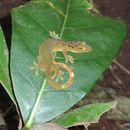en
names in breadcrumbs


Philippine lizards of the family Gekkonidae comprise 49 species (Taylor, 1915, 1922; Brown and Alcala, 1978) in 10 genera: Gehyra (1), Gekko (13), Hemidactylus (5), Hemiphyllodactylus (2), Lepidodactylus (6), Luperosaurus (8), Ptychozoon (1), Pseudogekko (4), and Cyrtodactylus (9), (Brown et al., 2007, 2010a, 2011; Welton et al., 2009, 2010a, 2010b; Zug, 2011). An amazing percentage of these species are endemic to the Philippines archipelago (roughly 85%; Brown et al., 2011). Several of the recently described gekkonids in the Philippines were discovered only recently as part of ongoing surveys around the archipelago. Recent phylogenetic studies focused on Philippine gekkonids (Siler et al., 2010; Welton et al., 2010a,b) have resulted in the observation of high levels of genetic diversity among populations of widespread species, an indication that the country's gecko diversity may still be greatly underestimated.
The genus Pseudogekko presently contains four species, all endemic to the Philippine islands (Pseudogekkobrevipes, Pseudogekkocompressicorpus, Pseudogekkosmaragdinus, Pseudogekkointermedium). Species in this genus are easily diagnosed from all other Philippine gecko species due to their long, slender, delicate body forms. All species appear to prefer arboreal habitats and are often found on leaves of saplings, trees, or aerial ferns. Specimens of most species remain rare in collections. Body coloration is quite variable both between species and between island populations within species, with Pseudogekko smaragdinustaking the prize for the most brilliant color pattern (neon yellow to green body). Although the diversity in the genus is currently recognized to be low, it is quite possible that widespread species are actually complexes of morphologically similar but distinct lineages.
In preservative: Dorsum dark brown to reddish-brown with some vague lighter blotches on the same specimens and four very irregular (wavy) narrow, black transverse bands between nape and the base of the tail followed by several similar bands on the tail; dermal expansions on the sides of the body and tail are often lighter brown; venter more tannish with some lighter blotches especially on head and tail. (Text taken from Brown and Alcala, 1978)
For more than 80 years, this species was known from the island population on Polillo Island in the northeastern portion of the Philippines. An amazingly colorful species, it was rarely observed on the island. Recent surveys however have not only resulted data showing the species to be quite common in the watersheds of Polillo Island, but the species has now been documented in multiple sites along the eastern coast of Luzon Island, as well as on the Bicol Peninsula of Luzon Island.
Pseudogekko smaragdinuscan be distinguished from congeners by the following combination of characters: (1) subdigital scansors undivided; (2) enlarged preanal and femoral pores in males 38-45; (3) enlarged preanal and femoral scales in continuous arched series; (4) enlarged preanal and femoral scale series extend over proximal half of thighs; (5) Toe-IV scansors 17-21; and (6) supralabials 14-19. Characters and character states from Brown and Alcala (1978).
Until recently, this species was believed to be endemic to the island of Polillo; however, recent surveys conducted by the University of Kansas and the Philippine National Museum have resulted in the discovery of multiple populations of Pseudogekko smaragdinusalong the eastern coast of Luzon Island (across from Polillo Island) as well as in the Bicol Peninsula of Luzon Island. Refer to the collections at the University of Kansas Natural History Museum (KU) for details about these recent collections.
Luzon Pleistocene Aggregate Island Complex (PAIC; Brown and Diesmos, 2002).
This specimen is commonly observed on the leaf axils and leaf surface of aerial ferns.
SVL 50-64 mm (Brown and Alcala, 1978)
Polillo Island, Philippines; type in the California Academy of Sciences; CAS 62336
Pseudogekko smaragdinus (or green smooth-scaled gecko, Polillo false gecko or emerald false gekko) is a species of gecko, which is one of the many types of lizard. It is endemic to the Philippines, where it is listed by the IUCN as "least concern," presumably because populations are currently stable; this gecko is fairly common in the forests of Polillo Island, however, it is quite difficult to find in most other areas.[1]
Pseudogekko smaragdinus (or green smooth-scaled gecko, Polillo false gecko or emerald false gekko) is a species of gecko, which is one of the many types of lizard. It is endemic to the Philippines, where it is listed by the IUCN as "least concern," presumably because populations are currently stable; this gecko is fairly common in the forests of Polillo Island, however, it is quite difficult to find in most other areas.